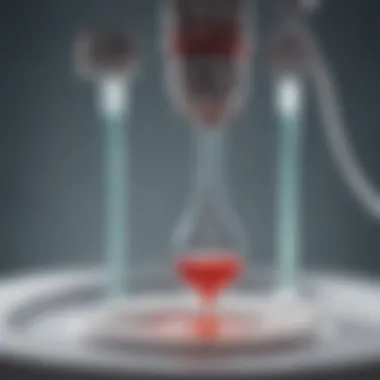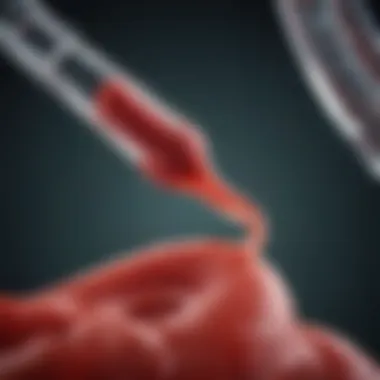Umbilical Cord Blood Sampling After Delivery Insights


Intro
Umbilical cord blood sampling is an increasingly relevant practice in modern obstetrics. It encompasses the collection of blood from the umbilical cord immediately after delivery. This process plays a crucial role in various medical applications, particularly in regenerative medicine and transplantation. As healthcare professionals continue to explore the potential of cord blood, understanding the methodology and ethical considerations becomes vital.
This section provides an overview of the key findings, methodology, and significance of umbilical cord blood sampling. It will explore how this practice not only impacts immediate care but also contributes to long-term medical advancements.
Prelims to Umbilical Cord Blood Sampling
Umbilical cord blood sampling is a vital procedure performed immediately after the birth of an infant. This practice has gained significant attention in the medical community due to its potential benefits. It involves collecting the blood remaining in the umbilical cord and placenta, which is rich in hematopoietic stem cells. These cells play a crucial role in medical treatments, especially for various blood disorders and certain types of cancer. Understanding this process not only sheds light on its significance within maternity care but also reveals the broader implications in regenerative medicine and therapeutic applications.
Definition and Context
Umbilical cord blood sampling refers to the extraction of blood from the umbilical cord following the delivery of a newborn. This blood contains stem cells, which are undifferentiated cells capable of developing into different cell types. This makes them incredibly valuable for medical treatments. The timing of this sampling is critical; ideally, it should occur soon after delivery, maximizing the quality and viability of the stem cells.
In recent years, medical advancements and a deeper understanding of stem cell properties have made cord blood a focal point for both clinical and research applications. The rise of cord blood banking has also underscored its growing importance for families and healthcare providers.
Historical Background
The concept of using umbilical cord blood for medical purposes is relatively new, yet its foundation is rooted in earlier advancements in stem cell therapy. The first successful umbilical cord blood transplant was performed in 1988. This groundbreaking procedure opened doors to new treatments for diseases such as leukemia and other blood disorders.
Since then, practices around umbilical cord blood sampling have evolved. Initial focus was mainly on transplant applications, but ongoing research is now looking into broader therapeutic uses. The establishment of public and private cord blood banks has further enhanced the accessibility of this resource. The growing body of evidence supporting the benefits of cord blood stem cells continues to propel this practice in clinical settings.
The Process of Umbilical Cord Blood Sampling
The process of umbilical cord blood sampling is a significant aspect to understand when exploring the value of cord blood. Immediate sampling after delivery holds immense potential in modern medicine. This section will delve into the timing, procedures, equipment, and preparation necessary for effective sampling. By comprehensively examining these elements, we can appreciate the practicality and relevance of this practice in healthcare.
Timing and Procedure
Timing plays a crucial role in umbilical cord blood sampling. Ideally, the procedure should be performed without undue delay after delivery. The best moment is usually when the umbilical cord is still pulsating. This is when the blood flow is most active, ensuring the collection contains viable cells without excessive exposure to the external environment. Sampling too late might result in a diminished quality of the blood sample.
The actual procedure involves several steps. First, after the baby is delivered, the healthcare team should ensure the newborn is well. Once confirmed, they clamp the umbilical cord in two places, cutting it between the clamps. Blood is then drawn using a sterile collection bag or syringe connected to the umbilical vein. This method minimizes contamination. Careful handling is essential; this includes ensuring that sterile techniques are employed at all stages. The process is efficient, generally taking only a few minutes to complete.
Equipment and Preparation
Proper equipment and preparation are vital for successful umbilical cord blood sampling. The healthcare team needs to have specific tools at the ready. This includes:
- Sterile collection bags or syringes: These should be made from materials that prevent contamination and ensure cell viability.
- Clamps: Used to secure the umbilical cord for accurate blood flow management.
- Scissors: For cutting the cord between clamps, they must also be sterilized.
- Alcohol swabs: Essential for disinfecting the area where sampling occurs.
- Labeling materials: For appropriately identifying samples to avoid confusion later.
Before the procedure, staff should prepare a designated workspace. It should be clean and organized to facilitate a seamless process. All necessary equipment should be within reach, minimizing fumbling during sampling.
Attention to both timing and preparation can greatly enhance the quality of cord blood samples. Immediately sampling cord blood under controlled conditions maximizes the potential it holds for various medical applications. > The efficiency of this sampling can impact future treatment possibilities significantly.
Advantages of Immediate Sampling
The advantages of immediate umbilical cord blood sampling after delivery are numerous and significant. This practice not only maximizes the quality and quantity of the collected blood but also opens the door to a wider range of potential applications in medical treatment and research. As healthcare continues to advance, understanding these advantages becomes crucial for professionals involved in obstetrics, neonatology, and regenerative medicine.
Cell Viability and Quality
One primary advantage of immediate sampling is the enhanced cell viability and quality of the cord blood. When umbilical cord blood is collected right after delivery, the cells are exposed to minimal oxidative stress and are less likely to be contaminated or compromised. This is critical for stem cell biology, as the functionality and potential applications of these cells heavily depend on their health status. It has been shown that cells collected in an immediate timeframe after birth retain more robust functionality compared to those stored for longer periods without proper temperature control or processing.


Research indicates that higher cell viability can lead to better outcomes in various therapeutic applications, especially in treatments related to ( hematopoietic conditions ) such as leukemia and other blood disorders. This aspect not only highlights the medical importance of timely collection but also underscores the need for well-established protocols to manage and process cord blood effectively.
Potential for Treatment Use
The potential for treatment use is another significant advantage of immediate umbilical cord blood sampling. Cord blood is rich in hematopoietic stem cells, which play an essential role in regenerating the blood system and the immune system. These cells can be used in various therapeutic interventions, especially in pediatric medicine.
Some key points regarding treatment possibilities include:
- Transplantation: Stem cells harvested from cord blood are often used in stem cell transplants. This has been successful in treating several conditions, including certain cancers, genetic disorders, and metabolic diseases.
- Regenerative Medicine: The versatility of stem cells makes them a focus in regenerative medicine. They show promise in repairing or regenerating damaged tissues.
- Clinical Trials: Ongoing research and numerous clinical trials are exploring new applications of cord blood stem cells beyond traditional uses, expanding their potential in innovative treatments.
"The timely collection of umbilical cord blood significantly impacts the potential health outcomes associated with its therapeutic use."
In summary, the advantages of immediate umbilical cord blood sampling after delivery are multifaceted. Enhanced cell viability and quality contribute positively to treatment efficacy. The expanding potential for treatment underscores the necessity of implementing immediate sampling protocols across medical practices. Adequate training and awareness among healthcare professionals can further optimize the benefits associated with this practice.
Ethical Considerations
Ethical considerations surrounding umbilical cord blood sampling are critical in ensuring the rights and welfare of both the newborn and the parents. The topic addresses numerous factors that can influence how this medical procedure is perceived and conducted. Ensuring adherence to ethical standards helps build trust in medical practices and can ultimately impact the willingness of parents to participate in such sampling.
Informed Consent
Informed consent is a fundamental principle in medical ethics. This principle requires that parents fully understand the risks, benefits, and implications of umbilical cord blood sampling before agreeing to it. The process should be clear, allowing parents to make an educated decision about whether to proceed. Parents must be informed about how their cord blood might be used in research or for treatment in the future.
Key elements of informed consent in umbilical cord blood sampling include:
- Clear Communication: Health professionals need to communicate in simple terms, avoiding medical jargon. This ensures that parents of various backgrounds can understand the procedure and its implications.
- Voluntariness: Parents should feel free to make a decision without pressure. They should know that opting out of cord blood collection will not affect their medical care.
- Comprehensive Information: Parents must receive detailed information on what cord blood is, how it can be stored, and the potential risks involved in sampling.
Ensuring thorough informed consent can lead to more ethical practices in medical settings while promoting greater transparency.
Ownership and Use of Cord Blood
Ownership and use of cord blood present complex ethical dilemmas. Once collected, questions may arise regarding who holds ownership of the cord blood and how it can be utilized. This topic becomes especially important in the context of advances in medical research and technology.
Factors affecting ownership and use of cord blood include:
- Legal Frameworks: Various countries have different laws related to the ownership of biological materials. Parents must be aware of the rights they hold concerning the cord blood collected at delivery.
- Intended Use: It is essential to clarify how the cord blood will be used. Will it be stored for possible future medical treatment for the child, donated for public use, or utilized in research? Clear communication on this aspect can mitigate misunderstandings.
- Long-term Implications: The long-term ownership of stored cord blood can lead to questions about the child’s rights as they grow. Are they entitled to know how their biological material is being used? Discussing these concerns prepares parents for future implications.
Ensuring clarity in ownership and ethical use of cord blood is paramount for fostering trust in medical advancements and practices.
Applications in Medical Research
The applications of umbilical cord blood sampling in medical research have garnered significant attention in recent years. Research in this area is crucial, as the potential of cord blood extends beyond immediate therapeutic use. This section will delve into two primary applications: stem cell research and regenerative medicine. Each application is vital, not just for understanding the biology underlying various diseases, but also for discovering and developing new treatments that can profoundly impact patient care.
Stem Cell Research
Umbilical cord blood is a rich source of hematopoietic stem cells. These stem cells are unique because they can develop into all types of mature blood cells, which includes red blood cells, white blood cells, and platelets. This characteristic is extremely beneficial for both research and clinical treatments, particularly in hematological disorders.
One significant advantage of utilizing umbilical cord blood for stem cell research is the lower risk of graft-versus-host disease compared to stem cells derived from bone marrow or peripheral blood. This makes cord blood cells a more preferable option for transplantation. Researchers are conducting various studies to understand how these cells can be used in regenerative medicine, targeting conditions like leukemia and other blood-related diseases.
Moreover, the increased availability of umbilical cord blood banks allows for a more extensive range of samples for researchers. This enhances the diversity of stem cell lines, which is critical for studying various genetic disorders. The extraction and preservation processes have also improved, facilitating more efficient collections.


Regenerative Medicine
Regenerative medicine is an innovative field that aims to repair or replace damaged tissues and organs. The role of umbilical cord blood in this field is promising, particularly regarding its potential for cell-based therapies. Researchers are investigating how cultured stem cells from cord blood can be used to treat conditions beyond blood disorders, such as spinal cord injuries, cerebral palsy, and even degenerative diseases such as Parkinson’s.
The underlying capacity of stem cells to differentiate into various cell types provides a framework for innovative treatments. For example, studies have indicated that umbilical cord blood-derived stem cells can support recovery in animal models of brain injury, showing potential pathways for advancing human therapies. While current applications in regenerative medicine are still in the experimental stages, the preliminary results are encouraging, suggesting a future where such therapies may become commonplace in clinical settings.
"Research into the applications of umbilical cord blood is not only expanding our understanding of stem cells but is also opening new avenues for catching up with challenging medical conditions."
As both stem cell research and regenerative medicine progress, it becomes increasingly clear that umbilical cord blood sampling is a fundamental aspect of modern medical research. Its versatility and the potential for groundbreaking treatments emphasize the need for continued exploration and investment in this area. Challenges and limitations remain, but the benefits currently seen pave the way for promising future developments.
Challenges in Umbilical Cord Blood Sampling
The practice of umbilical cord blood sampling is not without its obstacles. Understanding these challenges is essential for improving procedures and ensuring the best outcomes for patients. Both technical difficulties and regulatory hurdles can complicate the implementation of this important medical practice.
Technical Difficulties
Technical difficulties in umbilical cord blood sampling can arise during the collection process. These challenges include issues such as inadequate blood volume, contamination risks, and the need for proper aseptic techniques. Collecting a sufficient sample of blood can be hindered by factors like improper collection method or timing.
For instance, if the procedure is not performed immediately after delivery, the blood quality may degrade, impacting its viability for future use. Additionally, the training of personnel is critical; untrained staff may struggle with proper collection techniques, leading to errors.
Moreover, logistics play a vital role. The transportation of samples to cryopreservation facilities must be swift yet careful, to maintain sample integrity. In some cases, broken or malfunctioning equipment can compromise the collection process.
To address these technical challenges, training programs and continuous quality improvement measures are vital. Also, implementing standardized protocols can help ensure consistency and precision in sampling procedures.
Regulatory Hurdles
Regulatory hurdles pose significant challenges to umbilical cord blood sampling. Various jurisdictions have different regulations regarding the collection and storage of cord blood. Compliance with these regulations is critical to ensure the legitimacy of practices and safeguard patient rights.
Many countries require that the informed consent process be rigorously followed. This ensures that parents understand how their child's cord blood will be used, which might include research or therapeutic applications. In some regions, documentation must be meticulously maintained to demonstrate adherence to regulatory guidelines.
Moreover, ethical concerns also shape regulations. These concerning debates escalate around the ownership and future use of cord blood. Parents may have questions regarding their rights over the stored blood, making clear communication essential.
Understanding these regulations and navigating the complexities they present is paramount for practitioners in the field. Engaging with regulatory bodies and contributing to the development of clear guidelines can help facilitate better practices in the future.
Current Practices and Guidelines
The field of umbilical cord blood sampling has evolved significantly in recent years. Current practices and guidelines are crucial because they ensure that the process is standardized across different institutions. This safeguards the quality of the samples and enhances their potential for therapeutic applications. A uniform approach allows comparison of results across studies and helps to advance research.
Institutional Protocols
Various hospitals and medical institutions have developed their own protocols for umbilical cord blood sampling. These protocols are influenced by factors such as local regulations, available resources, and the specific applications intended for the collected samples.
Key elements often included in these protocols are:
- Training: Health care professionals involved in cord blood collection must undergo proper training.
- Timing: Guidelines dictate the optimal timing for sampling to maximize cell viability.
- Collection Equipment: Specific tools must be used to ensure sterility and prevent contamination.
- Storage Conditions: Samples must be stored under controlled conditions to preserve their integrity for future use.
These protocols are essential for maintaining quality control, ensuring safety for both the mother and the infant. Deviations from established protocols can lead to suboptimal samples, which diminishes their utility in research and treatment.
Global Standards


Beyond institutional protocols, global standards play a fundamental role in harmonizing practices in umbilical cord blood sampling. Organizations such as the World Health Organization (WHO) and the Foundation for the Accreditation of Cellular Therapy (FACT) provide guidance that institutions follow to ensure universally acceptable practices.
These global standards cover various aspects, including:
- Safety and Ethics: They emphasize safety measures and ethical considerations in the procurement and use of cord blood.
- Quality Assurance: Standards focus on methods to ensure high-quality samples, such as testing for infectious diseases.
- Regulatory Compliance: Institutions are urged to adhere to national and international regulations, thus promoting global collaboration in medical research.
Implementing these standards allows for cross-collaboration in research and increases the credibility of findings. By complying with global protocols, research institutions can also enhance the trust and confidence that expectant parents place in the cord blood collection process.
"The establishment of standardized practices is key to ensuring success in the field of cord blood research and treatment."
In summary, the current practices and guidelines concerning umbilical cord blood sampling are vital for ensuring quality, safety, and ethical integrity in this promising area of medicine.
Future Directions in Research and Practice
The future of umbilical cord blood sampling is promising and pivotal for medical advancements. This section delves into innovative collection techniques as well as enhanced applications in medicine. Both these aspects are crucial for maximizing the potential of cord blood, which is rich in stem cells and various bioactive components. As research evolves, exploring these areas may lead to significant breakthroughs in regenerative medicine and other therapies.
Innovative Collection Techniques
The traditional method of collection involves clamping and cutting the umbilical cord after delivery. However, recent research is being directed towards more effective and less invasive techniques. These methods aim to increase the volume of collected blood while ensuring the integrity and viability of the cells.
New techniques under investigation include:
- Passive drainage: Collecting blood through gravity instead of suction could be more gentle on the cells, thus preserving their viability.
- Dual-bag systems: These allow for simultaneous collection of both plasma and cellular components without contamination, thus providing higher quality samples.
- Mechanical stimulation: Methods that stimulate the placenta may lead to increased blood flow to the umbilical cord, enhancing overall collection.
Each of these innovative techniques has distinct advantages that can contribute to increased efficiency and better outcomes for future applications. Researchers continue to evaluate their effectiveness through clinical trials, aiming to refine these methods further.
Enhanced Applications in Medicine
The potential applications of umbilical cord blood are vast and still largely untapped. As methods improve and more samples are collected, the opportunities for therapeutic uses surge. Current exploration points toward several critical areas:
- Regenerative therapies: Stem cells derived from cord blood can be utilized in treatments for various diseases such as leukemia, lymphoma, and metabolic disorders. Continued studies are seeking to enhance success rates and broaden eligibility criteria for these therapies.
- Tissue engineering: The unique properties of umbilical cord blood can aid in generating tissues for transplantation. This could revolutionize approaches to treating injuries and congenital defects.
- Gene therapy: With advancements in genetic engineering, utilizing stem cells from cord blood holds promise for correcting genetic disorders before symptoms manifest.
"The exploration of enhanced applications of umbilical cord blood can redefine the paradigms of treatment in modern medicine."
As we continue to investigate these applications, collaboration among researchers, clinicians, and bioethicists will be critical to ensure the responsible use of this valuable resource. The integration of advanced collection methods alongside innovative medical applications will truly define the next chapter in umbilical cord blood research.
Finale
The conclusion of this article encapsulates the significance of umbilical cord blood sampling immediately after delivery. This practice, while seemingly straightforward, holds a wealth of implications for both clinical applications and broader medical research. The exploration of this topic demonstrates not only the practical benefits of immediate cord blood sampling but also the ethical considerations that shape its implementation.
Summary of Key Points
Umbilical cord blood sampling offers numerous advantages:
- Cell Viability and Quality: Immediate sampling ensures higher cellular integrity, crucial for effective future treatments.
- Potential for Treatment Use: The harvested stem cells can play a vital role in treating various diseases, thus expanding therapeutic horizons.
- Ethical Framework: The process ensures informed consent, addressing potential concerns around ownership and usage of biological materials.
- Research Applications: The extracted cells contribute significantly to stem cell research and regenerative medicine advancements.
- Regulatory Practices: Understanding institutional protocols and global standards ensures compliance and promotes safe practices.
These points illustrate the multifaceted nature of cord blood sampling and its essential role in modern healthcare.
Implications for Future Practice
As medical science continues to evolve, the implications of umbilical cord blood sampling become increasingly profound. Future practices may benefit from:
- Innovative Collection Techniques: Ongoing research pushes for improved methods that increase efficiency and efficacy in cord blood sampling.
- Enhanced Medical Applications: With advancements in biotech and regenerative medicine, the potential applications of collected cord blood will likely expand significantly.
- Educational Initiatives: Raising awareness among expecting parents regarding the benefits and processes involved can lead to more informed decisions.
- Policy Development: As the landscape of medical research grows, updating regulations surrounding cord blood usage will be necessary to align with new applications and ethical standards.
In summary, understanding the importance of umbilical cord blood sampling post-delivery establishes a foundation for appreciating its potential in medical progress. The investments made in policies, research, and education can enrich this area of medicine for future generations.







